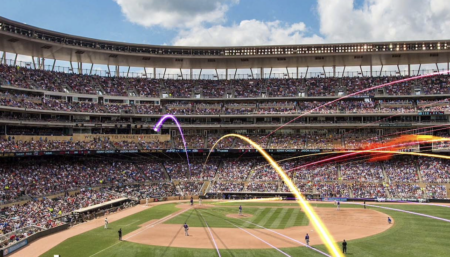Engineering and management consultancy Mott MacDonald and technology solutions company Restrata have teamed up to develop a five-step strategy to get sports fans back into stadia and enjoying live sports. The approach, which uses performance-based epidemiology principles alongside tried and tested digital technology, can be used by all stadia owners, enabling them to unlock sporting events which have been severely affected by Covid-19. It can also help businesses become more resilient to the impacts of future pandemics.
With many sporting events canceled last season, there was uncertainty as to whether competitions could conclude. As the situation changed, rescheduled fixtures took place behind closed doors, but this has led to the loss of significant financial income for the industry. In the UK, Premier League clubs are reported by Deloitte to have lost a collective £850 million last season, as a result of the loss of TV income and matchday revenue. Live Nation, a leading company in the live events sector, saw revenue plunge by 98% last quarter. There is potential for further financial loss unless systems are put in place to get fans back into venues and watching live sports.
In the UK, the government has issued a strategy with new guidelines to reopen stadia when it is safe to do so. Many sports clubs and associations need to understand what they have to do to comply and to minimize risk. To help with this and to help sport regain confidence, Mott MacDonald and Restrata have developed a five-step strategy to help clubs prepare for the return of fans. The strategy directly addresses the risks, and that safety certificates will only be issued if the requirements of local authorities, police and transport operators have been met both inside and outside the stadium.
Step One – define the challenges both inside and outside the stadium. The match day experience and exposure risk vary across the different fan ticketing packages in terms of how fans arrive at the stadium, what they do inside the stadium and the environment they interact with. A graduated inventory of fan behaviors and risks must be developed to model the fan journey from their home to the ground and through the stadium. This will also integrate the potential impact of COVID-19 incidence in the local community, how fans will arrive at the stadium using public transport, and the limitations these may present in addition to those inside the stadium.
Step Two – establish a baseline through a compliance audit. Where national government or sports authorities have issued guidelines, such as the SGSA planning for social distancing at sports grounds guidelines in the UK, clubs need to understand what is required to comply, where they have current compliance gaps and bottlenecks to achieving the allowable capacity in the stadium. Understanding the levels of staffing and stewarding required to meet the guidelines is essential, as is the increase in cleaning protocols and other operational needs. Clubs also need to understand the impact of the regulations on the venue revenue and operating profits in order to make capital investment and operational decisions.
Step Three – performance-engineered solutions. This approach offers clubs opportunities for improved performance and outcomes through a bespoke strategy that enhances risk management beyond the guidelines. Using complex, disease-specific epidemiological evidence overlaid on the compliance audit, it is possible to see how we can meet & exceed the guidelines miss and how challenges can be approached in a different way. Firstly, the risk of infection transmission throughout the stadium is modelled, identifying hotspots for risk of transmission and assessing how effective the existing guidelines are in addressing these risks. A targeted package of interventions to further reduce the risk of transmission is then identified with their relative risk reduction impacts. Finally, the reduced risk profile for the stadium can be used to reassure fans of the club’s commitment to spectator safety and to justify increased fan capacity above the limits that social distancing guidelines alone can achieve.
Step Four – interventions. Having already established the interventions that could be implemented across the stadium to further reduce the risk of virus transmission (beyond the social distancing guidelines), a business case approach is used to evaluate each intervention on the basis of risk reduction, returns/benefits and cost. This includes both physical interventions such as the supply of clean air through buildings services systems, ICT technologies to reduce the number of touchpoints, COVID-19 security technologies to monitor fan behaviors, and operational interventions such as stewarding, security and cleaning procedures. Effective communication and practical enforcement of interventions also needs to be considered.
Step Five – manage residual risk. Having now assessed and reduced the risks through steps one to four, there remains residual COVID-19 risk to manage. Technology management systems can monitor the risk, offer proof of compliance, and provide continual feedback during use on how the interventions are performing and what further adjustments are required in the future. With a data-driven approach to monitoring spectator behaviors after implementation of interventions, clubs can fine-tune their risk reduction strategies to demonstrate to fans and authorities a commitment to protecting the wellbeing of their fans.
As part of season ticket or pre-check risk assessments, health screening on non-matchdays can also improve community health and support track and trace. Information on fan movements and adjacencies through the stadium can be analyzed for future contact tracing of subsequently-diagnosed COVID-19 cases who attended the event. This data is stored securely in the cloud allowing transparent and open collaboration with the relevant authorities.
James Middling, Mott MacDonald’s built environment sector lead said: “Sport is an important and much needed part of any community and the trust between the club and its fans is at the very core of the business of sport. As fans start to return to our stadia, we need to work together to openly rebuild that trust and keep each other safe whilst enjoying a great day of sport. The fans need to be patient and follow the rules and the stadium operators need to show how they are managing the risks through applying world leading methods.
“We’ve come together with Restrata to deliver truly world class COVID-19 risk management which uses first principles epidemiology and engineering interventions to measure and reduce the risks then transparently manages the remaining risk through world leading technologies.”
Botan Osman, Restrata CEO said: “Through the first bio secure test series cricket we helped deliver between England and West Indies, and the other England series against Pakistan, Ireland and Australia, Restrata has been proud to lead the way for live sport to return this summer. We all want to see a return to live sport with fans in a safe and secure environment, with fan wellbeing at the heart of the approach, and that is why we have teamed up with Mott MacDonald to launch this five-step strategy to get sports fans back to stadia.
“Through the live government trial we conducted at the Oval in September in addition to bio-secure cricket this summer we have proven that, done the right way, a fan-secure environment in stadia is safer than the high street. We are pleased to team up with Mott MacDonald, to help teams, clubs, governing bodies, events and venues understand that live sport can get back on track – and regain the confidence needed to see fans safely back in the stadia.
“We have a clear, unequivocal message for when the ‘pause button’ on live sport is released: technology is a necessity to minimize the risk posed by this pandemic and provide a safe environment for fans.
“Our recent government pilot trial at the Oval proved that fans ability to comply with government safety measures was greatly enhanced by live data analysis and technical governance. Our system provides an environment that exceeds safety measures recommended by the government and we believe fans safety should be put first.
Chelsea Stefanska, global health security specialist at Mott MacDonald said: “Data is empowering. To be able to objectively identify and monitor the areas of highest risk enables us to develop targeted interventions that will make a demonstrable impact on transmission risk within the stadium. Compliance with guidelines is only the first step and the bare minimum; to actually reduce risk of virus transmission among spectators and avoid an outbreak linked to a sports event, we need to understand fan behaviors as they relate to a respiratory virus and enforce practical and effective mitigation measures within and around the stadium.”





